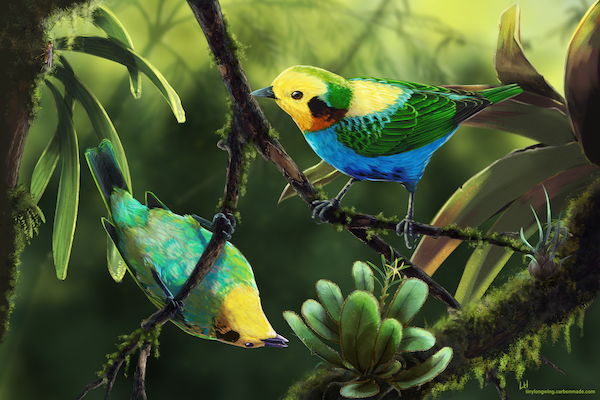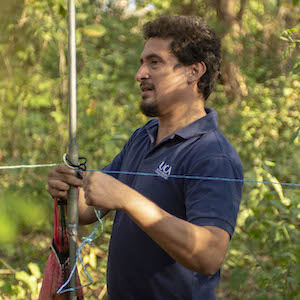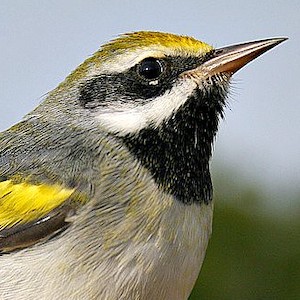The Andean Cloud Forest is a hot-spot for bird diversity. This ecosystem is home to 300 species of birds, many of which have very restricted ranges, and 23 of which are threatened. The region is wintering habitat for some neotropical migrants that are familiar to North Americans such as Swainson’s Thrush, Scarlet Tanager, Blackburnian Warbler and Canada Warbler. Sadly, the Andean Cloud Forest is also one of the Earth’s most endangered ecosystems. Deforestation and fragmentation of the forest for timber and conversion to agriculture began 400 years ago and continues to accelerate, yet scientists don’t yet fully understand how these processes affect biodiversity.

A Metallic-green Tanager. Photo by Harry Jones
Dr. Harry Jones, IBP’s new Southwest Avian Ecologist, worked with this imperiled bird community in Colombia’s Western Andes for his dissertation research. Jones and co-authors from the University of Florida, the Universidade Federal de Goías in Brazil, and the Universidad del Valle in Colombia, recently published a paper in the journal Global Ecology and Conservation examining how species richness, functional diversity and community composition of forest-dependent birds changes with forest fragmentation. We interviewed Harry about this research.
In layman's terms what is the take-home message of this research?
I'd say there are a couple. One is that forest-dependent birds, the ones that can't survive in coffee plantations or backyards, don't do well in fragments because they don't like forest edges, and they are likely outcompeted and replaced by bird species that are adapted to thrive in young forests. Second, we discovered that selective logging of forests is just as bad as forest clearing, in that it has the same negative effects on birds that like deep, dark forest interiors. So this practice, which is pretty common in Colombia, is almost as bad as forest clearing in terms of losing forest-dependent birds. When logging occurs in forest fragments it's amplifying the negative effects for forest birds.
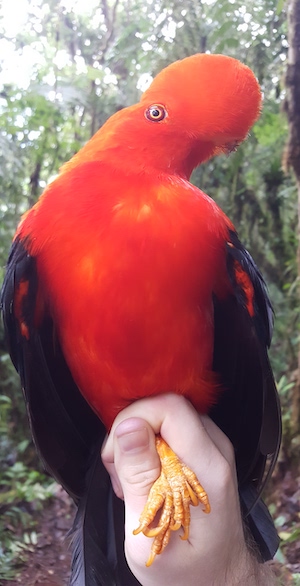
An Andean Cock-of-the-rock. Photo by Harry Jones.
One thing I want to make clear is that our study area is one landscape, and we need to be cautious about extending these results to all Andean fragmented landscapes throughout Colombia. Likely there are some 'worse case' aspects to our study area: the forest fragments are surrounded by cattle pasture, which make it hard for birds to cross to other forest patches, and the forest there was cut and fragmented decades ago, meaning many species had a long time to go extinct. Other landscapes with a more permeable matrix (shade coffee), with patches that were more connected by forest corridors, or that have been fragmented more recently might not show such a large loss of species with declining patch size. Unfortunately, future Andean agricultural landscapes are predicted to look a lot like our focal landscape.
You found that insectivores and carnivores responded differently to habitat patch size compared to nectivores and frugivores. Why do you think that is?
The main difference was that the nectarivores and frugivores showed a high species turnover, meaning that the species present are changing even if the overall number of species does not. In contrast, the insectivores and carnivores showed mainly species loss (total number of species decreasing) in smaller forest patches. Nectarivores and frugivores are birds that are closely tied to specific plants- some species exclusively drink the nectar or eat the fruit of one or a small handful of plants. So, changes to the plant community composition in small forest fragments will lead to changes in the species of birds that are present. Some plants like forest edges and canopy gaps and produce fruit and flowers in such environments (this is true in the temperate zone as well if you think about the amount of fruit and flowers in a weedy overgrown yard or field), creating food sources for the birds that are adapted to eat them.
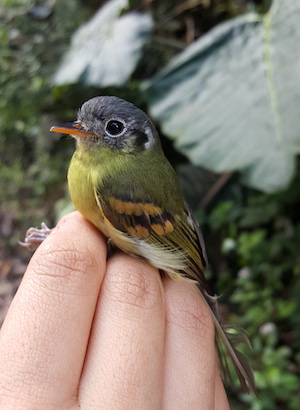
A Variegated Bristle Tyrant. Photo by Harry Jones
The insectivores are a really specialized bunch- most tropical birds are very specialized as far as where they hunt for insects (some only search in vine tangles, or in dead leaves, for example) and what height in the forest they look for food. Some species are always in the canopy, others like midstory vegetation or dark undergrowth. Unfortunately, when forests are fragmented and logged, they lose a lot of the structure that they used to have, and insectivores lose their favorite foraging locations. There isn't as much turnover because instead of changes to fruiting or flowering plants, there is just a loss of the diversity of microhabitats in which to look for food.
The story with carnivores is a bit different (I think). For many of these big birds at the top of the food chain, they need a big territory with a lot of prey to hunt in, and small forest patches may simply not have enough resources to support a big owl or hawk.
After this study and your work in Colombia in general, how optimistic are you about the fate of forest-dependent species in the Andean Cloud forest? Do you know of any efforts to create or sustain the kinds of large tracts of primary forest that these species need?
I think there are both reasons for optimism and pessimism. To start with the negative, there is ongoing forest clearing in the Colombian Andes and it is projected to increase over the next 30 years to satisfy the ever-growing demand for agricultural products (particularly beef.) Also, the majority of Colombia's population lives in the Andes, so urban expansion is a real concern.
What makes me (cautiously) optimistic is the fact that Colombia is only beginning to realize its potential as an ecotourism destination and environmental leader. For one, the Colombian government signed a peace deal with the FARC guerrilla group in 2016, ending 30+ years of civil war in the country. This has opened the door for a burgeoning ecotourism industry in a country that has the highest bird diversity on Earth (nearly 20% of the world' bird species and about half of all South American species), giving people an economic reason to conserve Andean forests.
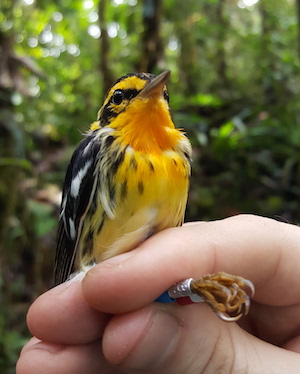
A Blackburnian Warbler Harry banded in the Andean Cloud Forest.
Second, the past few years have seen a vast increase in the number of conservation NGOs in Colombia, many spearheaded by young Colombian scientists, which has led to the creation of many private reserves to supplement the (inadequate) system of national parks. NGOs like ProAves and American Bird Conservancy have helped to create private reserves that are funded by ecotourism, while community-level NGOs (including my collaborators at an organization called Serraniagua have worked with land owners to help create conservation easements on their lands. For example, the reference site used for my study is a ~7000 ha private reserve created by Serraniagua. There are certainly signs of hope, but biodiversity loss will continue unless and until rural Colombians can be better educated about the value of the amazing biodiversity of their country and find livelihoods that do not depend on poaching or illegal logging.
What is one question you still have about the bird community in the Andean Cloud Forest?
One question that might be of interest is how North American migrants are being affected by forest fragmentation in this landscape. There are fourteen species of overwintering long-distance migrants that we detected in our surveys, including some threatened species such as Cerulean, Canada, and Golden-winged Warblers. The good news is that we didn't find statistical support that any of the migrants were negatively affected by fragmentation (many migrants were found in both small and large fragments), though there were trends suggesting that Cerulean Warbler and Broad-winged Hawk had a higher occupancy in larger patches of forest.
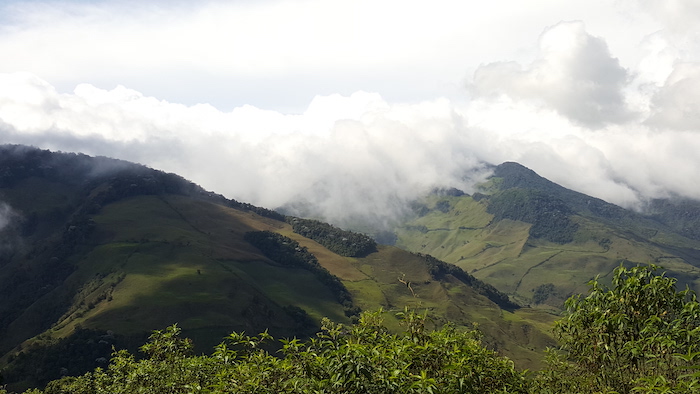
A view of forest fragmentation in the Andean Cloud Forest of Colombia. Photo by Harry Jones.


